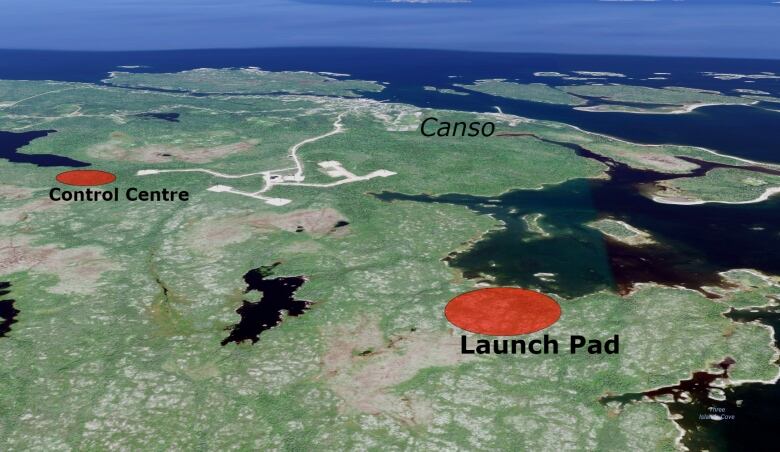Proposed Canso spaceport has clients lined up, says Maritime Launch Services
Project would have to undergo extensive assessment before a projected 2020 launch date

The company behind a proposed spaceport in coastal Nova Scotia says it has "several" clients committed to launching satellites,though it's not ready to divulge any more details.
"We do have letters of intent signed for payloads," said Steve Matier, president of Maritime Launch Services.
"Several is what I'll commit to at this point. We'll probably be making an announcement in the June time frame about them."
Maritime Launch Services plans to build a $100-million satellite launch facility roughly 2.5 kilometres from Canso, which is about 300 kilometres east of Halifax.
Canada's first orbital launcher?
Licensing a spaceport with orbital capabilities is uncharted territory for Canada.
Thecountry's only other space launch site opened in 1956 near Churchill, Man., and shut down in 1984. The Churchill Research Range was a sub-orbital test facility that could put rockets in space, but couldn't keep them there.
"Launch capability from Canada into orbit really changes things for usbecause we've never done something like that before from our soil," said Jesse Rogerson, a science adviser for the Canadian Aviation and Space Museum in Ottawa.
He saidif the Canso projectgoes ahead, it could save money for the Canadian government and for communications firms who now have to launch satellites in the U.S.
The Federal Aviation Administration in the U.S. has a long-standing licensing program for space launch facilities, however the regulatory process in Canada is untested.
NathalieGauthier, aspokesperson for Transport Canada,saidTransport Canada has the authority to control airspace through the Aeronautics Act, but no one in the department has personal experience with launch pads.
The Canadian Aviation Regulations provide a framework for licensing aircraft operations in Canada.Transport Canada would have to approve the location of a launch site and the restricted airspace above it.

Assessing risk
A spaceport company would have to conduct an aeronautical study on how launches would affect commercial aircraft.
"The department would also require a comprehensive risk assessment before any such operation would be approved," Gauthier said.
Matier saidthe risk assessment would address falling debris from a failed launch as well as risks from explosions and environmental releases of fuel.
According to the project description submitted to the Nova Scotia government,the Yuzhnoye C4M rockets to be used run on acombination of liquid oxygen and refined kerosene as first-stage propellants and more than 20,000 kilograms of self-igniting chemical fuel for the secondstage.
Failure rate for launches
Half of the chemical fuel is unsymmetrical dimethyl hydrazine (UDMH), which is a potent carcinogen and potentially explosive if exposed to air. UDMH breaks down in seawater in about two weeks.
If UDMH is released on land, it can react with air to create dimethylnitrosamine (DMN), a carcinogen that can contaminate groundwater and is difficult to filter and detect.
Matier said the Ukrainian-builtrockets Maritime Launch Servicesintends to use have a 98 per cent success rate over 208 launches. The two recorded failures happened near the edge of space, and never on the ground.He saidthe facility is designed to mitigate for possible leaks and that UDMH poses "zero" risk to drinking water.
"Even under the worst-case scenario, none of that stuff would get into the waterways," he said.
Matier said the studies will cost hundreds of thousands of dollars, but that the company has alreadybudgeted for them in its seed funding.
Proposed 2020 launch date
Transport Canada expects it will take Maritime Launch Services about a year to prepare its risk assessment. That would give the department a further two years to approve the application before theprojected first launch date in the summer of 2020.
Nova Scotia's Environment Department said it needs to approve an environmental assessment beforethe launch site canbegin construction, plus other approvals to alter wetlands and watercourses.
A spokesperson for provincialDepartment of Natural Resources said it's reviewing the company's application to lease Crown land at the proposed launch site.












_(720p).jpg)


 OFFICIAL HD MUSIC VIDEO.jpg)
.jpg)



























































































